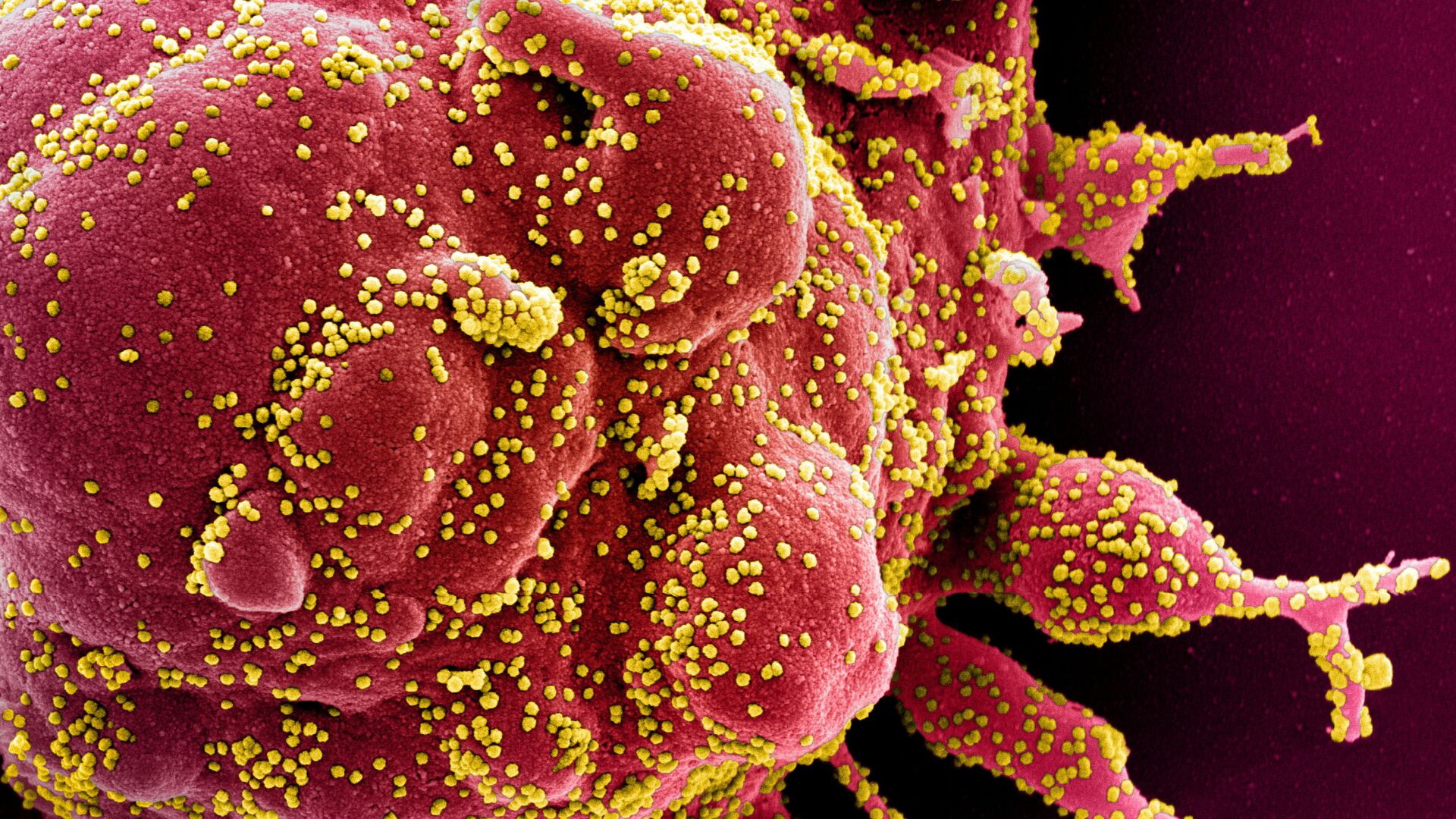https://sputnikglobe.com/20211228/from-pandemic-plague-to-seasonal-sniffle-how-viruses-mutate-into-milder-strains-to-survive-1091859984.html
From Pandemic Plague to Seasonal Sniffle: How Viruses Mutate Into Milder Strains to Survive
From Pandemic Plague to Seasonal Sniffle: How Viruses Mutate Into Milder Strains to Survive
Sputnik International
The advent of the Omicron variant of COVID-19 prompted a new wave of pandemic panic around the world, with many countries closing their borders and re-imposing... 28.12.2021, Sputnik International
2021-12-28T18:42+0000
2021-12-28T18:42+0000
2022-11-10T12:53+0000
omicron covid strain
evolution
genetic mutation
coronavirus
covid-19
delta variant of covid-19
omicron strain
botswana
pandemic
influenza
https://cdn1.img.sputnikglobe.com/img/07e5/06/1d/1083264831_0:355:2383:1695_1920x0_80_0_0_1756d8e22179baca0b180f1aab8a9ed8.jpg
Omicron has been the Greek letter on the world's lips for the last month as the new COVID-19 variant spread rapidly from southern Africa to all other inhabited continents.But some governments are now re-thinking their initial reactions to the latest variant of concern as doctors confirm initial observations from South Africa its symptoms are "very mild" despite it being far more contagious.It quickly usurped the previously-dominant Delta variant in Gauteng, the South African province at the centre of the outbreak. Estimates by the UK Health Security Agency indicated it had reached 90 per cent dominance in the UK on December 26Speaking about the Omicron variant earlier this month, Russian President Vladimir Putin noted that "some experts even call it 'live vaccination'."On Monday, the British government announced it would not tighten restrictions further, allowing New Year's Eve celebrations to go ahead in England.But long before Omicron appeared in Botswana, virologists had predicted that the virus — which has killed some 5 million people worldwide — would eventually evolve into a near-harmless form, which would ironically give it a selective advantage over previous variants.A novel strain of H1N1 influenza caused the 1918 pandemic following the First World War which killed 25-50 million people worldwide. But by 1920 it had mutated into a much milder form indistinguishable from other seasonal flu bugs. Will COVID-19 go the same way?Meaner Isn't Always Stronger The basic concept is simple: in order to thrive and continue its genetic line, a virus must spread from organism to organism. A virus that rapidly kills its host will have fewer opportunities to infect new ones.Unlike bacteria and amoebic pathogens, viruses cannot live and multiply freely in the wild. Scientific opinion has long been divided on whether viruses are true living organisms, since they lack replicative mechanisms of their own. Instead, they use the biochemical machinery of the cells they infect to make copies of their genetic material and the building blocks of the protein coat that surrounds it.The very measures taken by governments and health authorities in response to the pandemic — including quarantine and contact tracing — may be creating an artificial selective disadvantage for severe diseases by interfering with their spread, in a way which is not done with the common cold.One of the key traits of COVID-19 is that the infected patient becomes contagious before they begin to show symptoms. The vaccinated can still transmit the disease even if their immunity means they never get ill, unlike with viruses like measles or smallpox — which the World Health Organisation declared eradicated in 1980 after almost 200 years of immunisation.COVID-19 variants with higher virulence — the ability to sicken or kill — will be easier to spot and patients isolated faster, those who have experienced previous pandemics say.Immunologist Mark Cameron at Case Western Reserve University in Cleveland, was on the staff of a hospital in Toronto at the height of the SARS pandemic there in 2003. "People who got SARS got very sick, very fast and were easily identified, easily tracked and readily quarantined — and their contacts were also readily identified and quarantined," he told Knowable.Mutating Itself Into ExtinctionAnother factor working to neuter new pandemic viruses is the very thing that causes them to arise in the first place — often by jumping from one species to another, as COVID-19 is thought to have done — their ability to mutate and evolve in a short timeframe.Coronavirus is one of many viruses whose genetic information is carried on a single strand of RNA, the long-chain molecule used to translate the DNA of living cells into the proteins they code for. This class of viruses, which use the enzyme RNA-dependent RNA polymerase from host cells to copy their strand of genes, are known to have very high mutation rates."RNA virus evolution is so rapid that it can often be observed in real time", a paper by Edward Holmes, then of Pennsylvania State University, noted in 2009, in the order of one point-change in the code per replication.Holmes referred to previous research into vesicular stomatitis virus (VSV), another RNA-based pathogen. They found that around 40 per cent of mutations cause that line of the pathogen to go extinct. A further 30% were generally harmful to its survival and more than 25 per cent were merely of neutral effect. Just five per cent of mutations were actually beneficial to the virus, improving its fitness to survive.The paper also discussed how a high rate of mutations can give a selective advantage by creating beneficial new traits more rapidly, too much can be counter-productive if it prevents those good mutations from stabilising in the population. The fittest genotype can be find itself wiped out by a harmful random mutation cropping up, an event termed 'error catastrophe'. Another phenomenon is when a population crosses the 'extinction threshold' where bad mutations accumulate faster than natural selection can weed them out.The spread of the Delta variant from India in mid-2021, just as vaccination drives were really making progress in many countries, sparked concerns about its supposed ability to 'break through' existing immunity and its reported high level of virulence.But in Japan a strange thing happened. After peaking in late summer with daily case numbers exceeding 26,000, Delta mysteriously began to to fade away. By November this year only around 200 cases were detected per day.A team of researchers from the National Institute of Genetics and Niigata University, led by Professor Ituro Inoue, proposed that the virus had mutated itself into "self-destruction". Inoue's theory was that it had acquired too many mutations in its gene for an error-correcting protein called nsp14."Considering that the cases haven’t been increasing, we think that at some point during such mutations it headed straight toward its natural extinction," the professor concluded.Inoue believes the same fate befell SARS in 2004 — but that cannot be proved as the virus has now disappeared.
https://sputnikglobe.com/20211228/sputnik-v-developers-to-putin-trials-show-the-russian-vaccine-neutralises-omicron-strain-1091858897.html
botswana
south africa
Sputnik International
feedback@sputniknews.com
+74956456601
MIA „Rossiya Segodnya“
2021
James Tweedie
https://cdn1.img.sputnikglobe.com/img/07e4/08/1c/1080307270_0:3:397:400_100x100_80_0_0_7777393b9b18802f2e3c5eaa9cbcc612.png
James Tweedie
https://cdn1.img.sputnikglobe.com/img/07e4/08/1c/1080307270_0:3:397:400_100x100_80_0_0_7777393b9b18802f2e3c5eaa9cbcc612.png
News
en_EN
Sputnik International
feedback@sputniknews.com
+74956456601
MIA „Rossiya Segodnya“
Sputnik International
feedback@sputniknews.com
+74956456601
MIA „Rossiya Segodnya“
James Tweedie
https://cdn1.img.sputnikglobe.com/img/07e4/08/1c/1080307270_0:3:397:400_100x100_80_0_0_7777393b9b18802f2e3c5eaa9cbcc612.png
evolution, genetic mutation, coronavirus, covid-19, delta variant of covid-19, omicron strain, botswana, pandemic, influenza, sars coronavirus, lockdown, flu, south africa
evolution, genetic mutation, coronavirus, covid-19, delta variant of covid-19, omicron strain, botswana, pandemic, influenza, sars coronavirus, lockdown, flu, south africa
From Pandemic Plague to Seasonal Sniffle: How Viruses Mutate Into Milder Strains to Survive
18:42 GMT 28.12.2021 (Updated: 12:53 GMT 10.11.2022) The advent of the Omicron variant of COVID-19 prompted a new wave of pandemic panic around the world, with many countries closing their borders and re-imposing lockdowns. But as the less-harmful nature of the new strain becomes more apparent, scientific knowledge of how other deadly viruses mutated into everyday illnesses has been borne out.
Omicron has been the Greek letter on the world's lips for the last month as the new COVID-19 variant spread rapidly from southern Africa to all other inhabited continents.
But some governments are now re-thinking their initial reactions to the latest variant of concern as
doctors confirm initial observations from South Africa its symptoms are "very mild" despite it being far more contagious.
It quickly usurped the previously-dominant Delta variant in Gauteng, the South African province at the centre of the outbreak. Estimates by the
UK Health Security Agency indicated it had reached 90 per cent dominance in the UK on December 26
Speaking about the Omicron variant earlier this month, Russian President Vladimir Putin
noted that "some experts even call it 'live vaccination'."
On Monday, the British government announced it
would not tighten restrictions further, allowing New Year's Eve celebrations to go ahead in England.
But long before Omicron appeared in Botswana, virologists had predicted that the virus — which has killed some 5 million people worldwide — would eventually evolve into a near-harmless form, which would ironically give it a selective advantage over previous variants.
A novel strain of H1N1 influenza caused the 1918 pandemic following the First World War which killed 25-50 million people worldwide. But by 1920 it had mutated into a much milder form indistinguishable from other seasonal flu bugs. Will COVID-19 go the same way?
Meaner Isn't Always Stronger
The basic concept is simple: in order to thrive and continue its genetic line, a virus must spread from organism to organism. A virus that rapidly kills its host will have fewer opportunities to infect new ones.
Unlike bacteria and amoebic pathogens, viruses cannot live and multiply freely in the wild. Scientific opinion has long been divided on whether viruses are true living organisms, since they lack replicative mechanisms of their own. Instead, they use the biochemical machinery of the cells they infect to make copies of their genetic material and the building blocks of the protein coat that surrounds it.
"I believe that viruses tend to become less pathogenic," Burtram Fielding, a coronavirologist at the University of the Western Cape in South Africa told
Knowable magazine last year. "The ultimate aim of a pathogen is to reproduce, to make more of itself. Any pathogen that kills the host too fast will not give itself enough time to reproduce."
The very measures taken by governments and health authorities in response to the pandemic — including quarantine and contact tracing — may be creating an artificial selective disadvantage for severe diseases by interfering with their spread, in a way which is not done with the common cold.
One of the key traits of COVID-19 is that the infected patient becomes contagious before they begin to show symptoms. The vaccinated can still transmit the disease even if their immunity means they never get ill, unlike with viruses like measles or smallpox — which the World Health Organisation declared eradicated in 1980 after almost 200 years of immunisation.
COVID-19 variants with higher virulence — the ability to sicken or kill — will be easier to spot and patients isolated faster, those who have experienced previous pandemics say.
Immunologist Mark Cameron at Case Western Reserve University in Cleveland, was on the staff of a hospital in Toronto at the height of the SARS pandemic there in 2003. "People who got SARS got very sick, very fast and were easily identified, easily tracked and readily quarantined — and their contacts were also readily identified and quarantined," he told
Knowable.

28 December 2021, 11:47 GMT
Mutating Itself Into Extinction
Another factor working to neuter new pandemic viruses is the very thing that causes them to arise in the first place — often by jumping from one species to another, as COVID-19 is thought to have done — their ability to mutate and evolve in a short timeframe.
Coronavirus is one of many viruses whose genetic information is carried on a single strand of RNA, the long-chain molecule used to translate the DNA of living cells into the proteins they code for. This class of viruses, which use the enzyme RNA-dependent RNA polymerase from host cells to copy their strand of genes, are known to have very high mutation rates.
"RNA virus evolution is so rapid that it can often be observed in real time", a
paper by Edward Holmes, then of Pennsylvania State University, noted in 2009, in the order of one point-change in the code per replication.
Holmes referred to previous research into vesicular stomatitis virus (VSV), another RNA-based pathogen. They found that around 40 per cent of mutations cause that line of the pathogen to go extinct. A further 30% were generally harmful to its survival and more than 25 per cent were merely of neutral effect. Just five per cent of mutations were actually beneficial to the virus, improving its fitness to survive.
The paper also discussed how a high rate of mutations can give a selective advantage by creating beneficial new traits more rapidly, too much can be counter-productive if it prevents those good mutations from stabilising in the population.
The fittest genotype can be find itself wiped out by a harmful random mutation cropping up, an event termed 'error catastrophe'. Another phenomenon is when a population crosses the 'extinction threshold' where bad mutations accumulate faster than natural selection can weed them out.
The spread of the Delta variant from India in mid-2021, just as vaccination drives were really making progress in many countries, sparked concerns about its supposed ability to 'break through' existing immunity and its reported high level of virulence.
But in Japan a strange thing happened. After peaking in late summer with daily case numbers exceeding 26,000, Delta mysteriously began to to fade away. By November this year only around 200 cases were detected per day.
A team of researchers from the National Institute of Genetics and Niigata University, led by Professor Ituro Inoue, proposed that the virus had mutated itself into "self-destruction". Inoue's theory was that it had acquired too many mutations in its gene for an error-correcting protein called nsp14.
“We were literally shocked to see the findings,” Inoue told The Japan Times. “The delta variant in Japan was highly transmissible and keeping other variants out. But as the mutations piled up, we believe it eventually became a faulty virus and it was unable to make copies of itself."
"Considering that the cases haven’t been increasing, we think that at some point during such mutations it headed straight toward its natural extinction," the professor concluded.
Inoue believes the same fate befell SARS in 2004 — but that cannot be proved as the virus has now disappeared.





